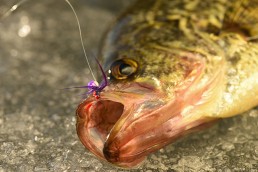Next-level Spinnerbaits: Create Custom Baits on the Fly
SHARE THIS POST
The spinnerbait is a lure that many bass anglers first began throwing at a young age, as it is versatile, easy to cast, pretty snag-resistant and most importantly, it catches bass!
Some anglers as they have progressed along their fishing journey have left the spinnerbait by the wayside, but other anglers have embraced the spinnerbait and understand its incredible potential. What these anglers realize is that each and every spinnerbait out there is different and there are numerous ways a spinnerbait can be customized to the conditions on the water.
Here is a look at how the components and design of a spinnerbait differ from one brand to another and ways in which a spinnerbait can be customized. This obviously goes beyond the options of being able to select a spinnerbait that can range in weight from 1/8-ounce all the way up to 1-1/2-ounces along with the different head and skirt colors.
Head design
There are two common head designs that are used for spinnerbaits, the first and most common is the bullet-shaped head; this head is great for fishing around vegetation, as it will slide through it with ease. The round or aspirin head design is used by anglers looking for a more compact approach, especially in river current where they don’t want their bait to get blown around by the current.
Wire gauge
The gauge of the wire that is used for the frame of your spinnerbait plays a major role in how much vibration the bait emits and how much you feel on your end when reeling it in. Some company’s use a smaller gauge wire, which emits a lot of vibration on your end; others stick with a standard gauge.
Blades & blade combination
Here is a look at the three common blade designs and when they shine:
Colorado: this blade puts off a lot of vibration, which is good for cold or stained water and when you need to slow roll your spinnerbait.
Willowleaf: this blade puts off a lot of flash, which is a good thing to have when the water is clear and the bass are gorging themselves on baitfish.
Are you enjoying this post?
You can be among the first to get the latest info on where to go, what to use and how to use it!
Indiana: this blade is a combination of the above-mentioned two, as it puts off a good amount of vibration, but also emits a good amount of flash. I lean to using this blade more in the spring than anything.
One of the great things about a spinnerbait is that with good split ring pliers, like the one made by Eagle Claw, you can quickly change out the blades and configuration to fit the conditions you face.
Some of my favorite blade configurations include a single Colorado or Indiana blade in the spring when I need to slow roll my bait, with either of these blades they still emit a lot of vibration even with the slow retrieve. From late May through June, I like a tandem blade combination with a small Colorado blade on the wire shaft and then a willowleaf blade at the end of the bait. This combination is an all-around good choice for emitting flash and vibration. When the bass get feeding on the shad heavily in late summer or the fall, a double willowleaf configuration puts off a lot of flash, thus emulating fleeing baitfish.
Trailers
The water clarity, temperature and what the bass are feeding on will dictate what type of trailer you rig on your spinnerbait. Some options include your standard split tail spinnerbait trailer, which is an all-around good choice to provide some additional action, without adding too much bulk. If the water temperature is cold, you are fishing deep, or need some extra action on the back of your bait, then a double tail grub is a good option. Another way to add bulk and action to your spinnerbait, and is a great option if the bass are feeding on baitfish, is a swimbait, such as the Zoom Swimmin Super Fluke or Swimmin Super Fluke Jr.
My choice of a spinnerbait is a War Eagle, as I feel its head design and wire gauge allows me to fish in a multiple scenarios and get the feel of what my bait is doing at all times. With its unique nickel or gold head colors, it catches the bass’s attention in any water clarity. The skirts on a War Eagle are also wire tied on, resulting in a more natural profile in the water.
The equipment that I use to throw a spinnerbait begins with the reel. If I’m slow rolling it, then I want to use a lower gear ratio reel. If I’m burning my bait, I’ll go with a high-speed ratio. The Wright & McGill Victory Pro Carbon reel is available in both models a 6.4:1 (low) and 7.9:1 (high). Regardless of the reel choice, I like to use a 7-foot rod, as that size I can make casts in tight quarters, but still make long casts on open flats. I use the Wright & McGill Victory Pro Carbon Spinnerbait Rod. My line choice is 15-pound-test Seaguar TATSU Fluorocarbon, as it casts easy and is very abrasion resistant so I can fish around nasty cover and not have to worry about my line breaking.
So as you prepare for you next fishing trip, make sure you know your spinnerbait anatomy and be prepared to make some modifications on the water so you can make the most out of your spinnerbaits!
Glenn Walker is a tournament fisherman who loves to spread his passion and knowledge of the sport through articles and videos. For more information visit Walker’s website: glennwalkerfishing.com or follow him on Facebook: facebook.com/glennwalkerfishing.
MWO
SHARE THIS POST
Did you enjoy this post?
You can be among the first to get the latest info on where to go, what to use and how to use it!
Glenn Walker
Glenn Walker has been fishing Minnesota and Mississippi River tournaments for more than 15 years, spreading his passion and knowledge of the sport via articles and videos. For more information, check out glennwalkerfishing.com or on Facebook @GlennWalkerFishing.



